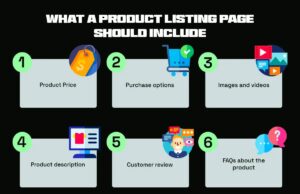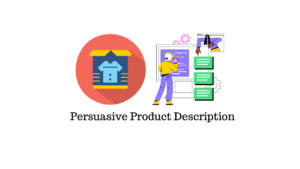A well-crafted product listing can be the difference between a casual browser and a delighted buyer. With countless options at their fingertips, shoppers are often overwhelmed, making it crucial for your products to stand out in a sea of competition. A compelling product listing not only showcases the features and benefits of your items but also tells a story that resonates with your audience, evoking emotion and urgency to click “Add to Cart.”
In this blog post, we’ll delve into essential tips for creating captivating product listings that not only attract attention but also convert visitors into loyal customers. You’ll learn how to transform your listings into powerful sales tools that drive success for your online store.
What is product listing?
A product listing is a digital storefront showcasing your product to potential customers. It’s your opportunity to grab attention, provide essential information, and entice buyers to make a purchase. A well-crafted product listing is crucial for driving sales and building a successful online store.
Understanding the importance of product listings
Effective product listings serve several key purposes:
- Discoverability: Helps customers find your product through search engines and online marketplaces.
- Persuasion: Convinces potential customers to choose your product over competitors.
- Information: Provides essential details about the product, such as features, benefits, and specifications.
- Conversions: Drives sales by encouraging customers to add products to their cart.
Essential elements of a product listing

- High-quality images: Use clear, professional product images from multiple angles. Consider showcasing the product in use.
- Compelling product title: Create informative and keyword-rich titles that accurately describe the product.
- Detailed product descriptions: Write engaging and informative descriptions highlighting key features, benefits, and usage instructions.
- Customer reviews: Encourage customers to leave reviews and display them prominently.
- Pricing and availability: Clearly display the product price and indicate whether it’s in stock.
- Call-to-Action (CTA): Use strong CTAs like “Add to Cart” or “Buy Now” to encourage purchases.
- Product specifications: Provide detailed information about the product’s dimensions, materials, and technical specifications.
Understanding your target audience
Understanding your target audience is the cornerstone of crafting compelling product listings that not only capture attention but also drive conversions. Before you even begin to write your product descriptions, take the time to research who your ideal customers are. Consider their demographics, interests, pain points, and shopping behaviors. Are they busy professionals looking for efficiency? Or perhaps they are eco-conscious consumers in search of sustainable options? Knowing these details will enable you to tailor your language, tone, and even the benefits you highlight in your listings.
Once you have a clear picture of your audience, think about the emotional triggers that resonate with them. What problems do your products solve, and how do they enhance their daily lives? Use this insight to frame your product features in a relatable way. For instance, instead of simply stating that a blender has a powerful motor, you might explain how it can help busy parents whip up nutritious smoothies in seconds, making healthy eating easier for the whole family.
Additionally, consider the language and terminology that your audience uses. Incorporating industry-specific jargon or colloquial terms can create a sense of familiarity and trust. However, be careful not to overdo it; clarity should always come first. Lastly, encourage engagement by asking questions or inviting feedback. This not only fosters a connection with potential buyers but also provides valuable insights that can help you refine your listings further.
Writing persuasive product descriptions

Writing persuasive product descriptions is a crucial element of crafting compelling product listings that not only attract shoppers but also drive conversions. A well-written description does more than simply list the features of a product; it paints a vivid picture that resonates with potential buyers and addresses their needs.
Focus on the benefits: What problems does it solve? How does it enhance the customer’s life? This understanding will guide your narrative and help you create a connection with your audience.
Use engaging language that evokes emotion: Instead of saying, “This chair is comfortable,” try, “Sink into the plush embrace of this chair after a long day, where each cushion feels like a gentle hug waiting for you.” Employ sensory words that allow shoppers to imagine the texture, smell, or experience of using your product.
Tell a story: Share a brief scenario of how the product can be used—perhaps envisioning a cozy evening spent with a loved one on your beautifully designed sofa. This approach not only showcases the product but also invites the shopper to picture it in their own life.
Use strong keywords: Incorporate relevant keywords naturally throughout the text to enhance visibility without compromising the flow or readability.
Include strong calls to action: CTAs such as “Transform your home today!” or “Join countless satisfied customers and make this yours now!”
Include important details: Provide essential information like size, color, and material.
Proofread carefully: Ensure there are no errors or typos in the description.
Optimizing product listings for search engines
When it comes to crafting compelling product listings, optimizing for SEO is a crucial step that can significantly enhance your visibility online. In a crowded ecommerce landscape, simply having a great product isn’t enough; you need to ensure that potential customers can easily find it.
- Keyword research: Identify the phrases and terms your target audience is using to search for products similar to yours. Incorporate these keywords into your product titles, descriptions, and tags without compromising the readability or integrity of your content.
Start with your product title—this should be clear, descriptive, and include your primary keyword. For instance, instead of a vague title like “Stylish Bag,” opt for “Eco-Friendly Canvas Tote Bag for Everyday Use.” This not only improves searchability but also immediately informs shoppers about what they can expect. In the product description, aim for a balance of informative content and persuasive language. Use bullet points to highlight key features and benefits, making it easier for shoppers to skim through the information.
- Image optimization: Images should be optimized for fast loading while showcasing your product from various angles. Adding alt text with relevant keywords will help search engines understand the content of your images, further boosting your SEO efforts.
- Product categories: Choosing the right product categories is crucial for ensuring your products are easily discoverable by potential customers. Organizing your product catalog effectively, you improve search engine visibility and enhance the overall shopping experience. Break down your product range into specific categories and subcategories. For instance, an electronics store might have categories like “Laptops,” “Smartphones,” and “Cameras,” with further subcategories like “Gaming Laptops,” “Apple iPhones,” and “DSLR Cameras.”
- Internal linking: Internal linking involves strategically linking to other relevant pages within your website to improve navigation and SEO. By connecting related products, you guide customers through your catalog and help search engines understand your website’s structure. For example, a product page for a blue dress might include links to other blue items, dresses in the same style, or complementary accessories like a matching handbag or necklace.
- Customer reviews and ratings: These not only provide social proof but also enhance the content with fresh, user-generated keywords that can positively impact your search rankings. In addition, these authentic voices not only lend credibility to your products but also build trust among prospective buyers. Shoppers are more likely to make a purchase when they see positive feedback from others who have experienced the product firsthand.
Leveraging visuals
When it comes to crafting compelling product listings, the visual appeal of your items cannot be overstated. Utilizing high-quality images and videos is essential for captivating potential buyers and ensuring they fully appreciate the details and features of your products. Start with crisp, well-lit images that showcase your product from multiple angles, allowing shoppers to visualize what they are purchasing. A clean, clutter-free background can help draw attention to your item, making it the focal point of the listing.
Consider incorporating lifestyle images that demonstrate how the product can be used in real-life settings. For example, if you’re selling furniture, show it styled in an inviting living room or cozy bedroom. This not only helps customers imagine the item in their own space but also evokes an emotional connection that can lead to conversions.
Videos can further enhance your listings by providing a dynamic view of the product in action. Demonstrating how to use your item or showcasing its unique features through a brief video can significantly boost engagement. An informative video can answer common questions, thereby reducing purchase hesitation and instilling confidence in shoppers.
It’s also crucial to optimize your images and videos for fast loading times, as slow performance can deter potential buyers. Ensure that your images are appropriately sized and compressed without sacrificing quality.
In conclusion, crafting compelling product listings is essential for standing out in the crowded world of eCommerce. Implementing the strategies discussed—such as focusing on engaging descriptions, high-quality images, and strategic use of keywords—you can significantly enhance your listings’ appeal. Remember, each product listing is not just a simple description; it’s an opportunity to tell a story that resonates with potential buyers. Use the power of persuasive language to highlight the unique features and benefits of your products, and don’t underestimate the role of customer reviews in building trust and credibility. As you refine your listings, keep your target audience in mind, tailoring your content to meet their needs and desires. With a little creativity and attention to detail, you can create product listings that don’t just attract clicks, but also convert those clicks into sales, helping to grow your business and foster lasting relationships with your customers.
